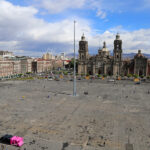
The Glorieta de las Mujeres que Luchan, literally the Glorieta of the Women’s Struggle, has played center stage for much of the women’s movement in Mexico City. The glorieta has also been the center of some controversy for a few years. The monument itself has been the symbolic center-stage of the women’s marches, protests, and civil actions.
In October of 2021, the Mexico City government announced the intention to rename the monument in honor of indigenous women. It will eventually feature a replica of the figure Young Woman of Amajac. The original is in the possession of the National Institute of Anthropology and History (INAH). It was unearthed in January of 2021 on the edge of the Tuxpan River in Veracruz. The limestone figure may represent a female leader of the Huastec people although she bears some relation to a fertility goddess, too.
That it’s the former monument to Christopher Columbus belies no irony. Over the years, the Reforma statue of Columbus became the frequent target of activists. In October of 2020, the city decided to remove the statue to send it for cleaning and restoration. It was later relocated to the more politically benign Parque América in Polanco.
Alas, the loss of the Columbus monument was not a matter of grave concern to City residents. In fact, another monument to Columbus stands about 850 meters (an 11-minute walk), directly north in the Buenavista neighborhood. The Plaza de Buenavista Columbus statue was sculpted in plaster by Manuel Vilar in 1858. The bronze cast came about in 1892. It was dedicated in that same year by then-president, Porfirio Díaz.
And so, the Glorieta de Mujeres que Luchan welcomes a new monument. Of the ten glorietas on Reforma, this one is among the oldest. For the man who ushered in the Anthropocene Era, our own, its perhaps more symbolic than ever. Strollers today, upon reaching the glorieta, can proceed to the Tabacalera neighborhood to the north. To the south is the Colonia Juárez. Of note is also the historical clock of the Hotel Imperial. This has been there at the corner of the Avenida Morelos since the hotel opened in the 1930.
![]() The Turibus Historic Center Circuit stops on southeast quadrant of the glorieta, outside the Fiesta American still on the Paseo de la Reforma.
The Turibus Historic Center Circuit stops on southeast quadrant of the glorieta, outside the Fiesta American still on the Paseo de la Reforma.
![]() The Capital Bus Center-Polanco Route stops on the southwest quadrant of the glorieta near the intersection with the Avenida Morelos. Buses from here continue eastward into the Historic Center. The stop is very convenient to the East Juárez and Tabacalera neighborhoods.
The Capital Bus Center-Polanco Route stops on the southwest quadrant of the glorieta near the intersection with the Avenida Morelos. Buses from here continue eastward into the Historic Center. The stop is very convenient to the East Juárez and Tabacalera neighborhoods.

Nearest at 0.17 kms.

Nearest at 0.23 kms.

Nearest at 0.28 kms.



A main entrance to Chapultepec park, flanked by historic lions...

There's no center like the very center, and in Mexico City, that means el Zócalo!

Likely the most prominent symbol of Mexico City, El Ángel is always at the center of things...

One of Reforma's most striking "glorietas," the Diana is more than a copy of some Euro original. It's homegrown!